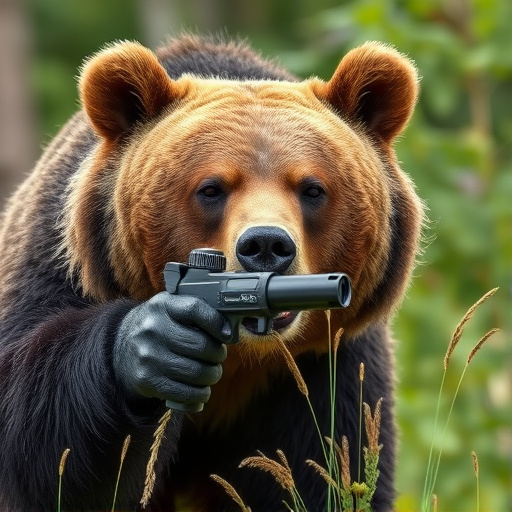Bear spray, designed for wildlife deterrence, surpasses traditional pepper spray in potency and unique formulation, targeting bears' eyes and respiratory systems with success rates up to 90%. Unlike lethal weapons, it offers a safe alternative for outdoor enthusiasts. While often perceived as stronger, bear spray's effectiveness varies by product, manufacturer, and weather; its goal is to deter an attack temporarily rather than incapacitate. Proper usage, storage, and combination with other safety measures enhance its reliability in bear-infested areas.
In the rugged wilderness of Alaska, encountering bears is a real possibility. This makes understanding bear spray safety crucial for outdoor enthusiasts and residents alike. This comprehensive guide explores the effectiveness of bear spray compared to pepper spray, delving into its composition and power. We’ll navigate the safety aspects, including proper usage, storage, and alternative precautions, ensuring you’re prepared for any potential encounters while exploring Alaska’s pristine landscapes. Discover why knowing the nuances of bear spray is vital for navigating this unique ecosystem safely.
- Understanding Bear Spray: A Closer Look at Its Composition and Efficacy
- Comparing Bear Spray to Pepper Spray: Unraveling the Strength Debate
- Safety Considerations: Proper Use, Storage, and Alternative Measures for Bear Spray
Understanding Bear Spray: A Closer Look at Its Composition and Efficacy
Bear spray, also known as bear deterrent or pepper spray designed for wildlife, is a crucial tool for those venturing into bear country. Unlike traditional pepper spray used for self-defense against humans, bear spray is formulated to create a safe but powerful barrier between you and bears. Its primary active ingredient is capsaicin, the same compound that gives chili peppers their heat. However, bear spray typically contains a higher concentration of capsaicin, making it far more potent than standard pepper spray.
When used correctly, bear spray can effectively deter aggressive bears by irritating their eyes and respiratory system. Studies have shown that bear spray is highly successful in preventing attacks, with usage rates as high as 90% in some research. This makes it a game-changer for hikers, campers, and hunters who may encounter bears unexpectedly. Unlike firearms or other weapons, bear spray offers a non-lethal option for self-defense, ensuring the safety of both humans and bears while allowing for a safe resolution to potentially dangerous situations. Furthermore, understanding its composition helps users appreciate that bear spray is indeed stronger than standard pepper spray, offering a more reliable means of protection in bear-infested areas.
Comparing Bear Spray to Pepper Spray: Unraveling the Strength Debate
When considering bear spray versus pepper spray, one of the most common questions arises from the debate over strength. Many assume that bear spray is inherently stronger due to its specific design for dealing with larger, more aggressive bears like grizzly and black bears. However, this isn’t always the case. Pepper spray, regulated for civilian use, has varying concentrations measured in capsaicin units (CU). Bear spray, while potent, typically adheres to different industry standards and may not consistently exceed the maximum CU levels of pepper spray.
This doesn’t mean bear spray is weak; it’s tailored for effective range, knockdown effect, and quick dispersal in a wide area. Still, the strength discussion highlights the importance of understanding the nuances between these two types of spray. In terms of Is Bear Spray Stronger Than Pepper Spray?, the answer isn’t a straightforward yes. It depends on the specific product, manufacturer, and active ingredient concentrations.
Safety Considerations: Proper Use, Storage, and Alternative Measures for Bear Spray
Bear spray is a popular tool for personal safety in areas where bears are present, but understanding its proper use and limitations is crucial. When considering bear spray safety, one of the primary concerns is its effectiveness compared to other options, particularly pepper spray. While commonly believed to be stronger, bear spray’s potency varies significantly based on factors like can size, concentration, and weather conditions. It’s important to note that bear spray is designed to create a barrier between you and the bear, causing temporary disorientation and pain to deter an attack rather than permanently incapacitating the animal.
Proper storage and use are essential for bear spray safety. Always store it in its original container, keeping it out of reach of children and pets. Ensure you understand the spray’s range and activation mechanism before venturing into bear country. Alternative measures, such as noise makers or bear deterrents, can also be effective. However, bear spray remains a reliable option when combined with other safety practices like making noise while hiking and avoiding unexpected encounters.
Bear spray, while often considered a game-changer in wild encounters, is not universally superior to pepper spray. The effectiveness of both largely depends on personal factors and specific scenarios. When it comes to safety, understanding the unique properties and proper usage of bear spray is crucial for navigating Alaska’s rugged landscapes. Always remember that prevention, such as making noise while hiking, should be your first line of defense, and carrying bear spray is a responsible backup plan.
